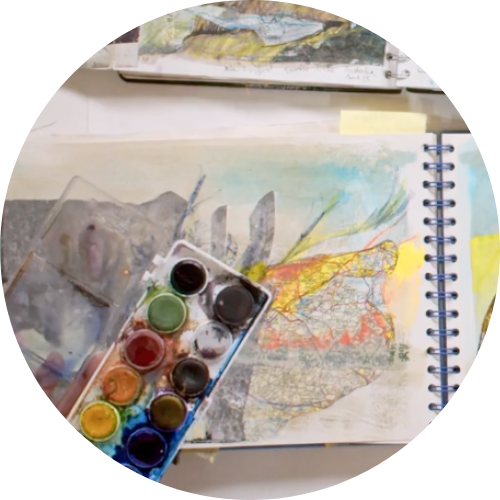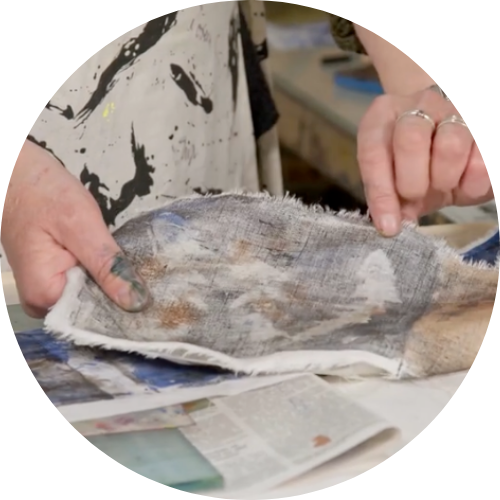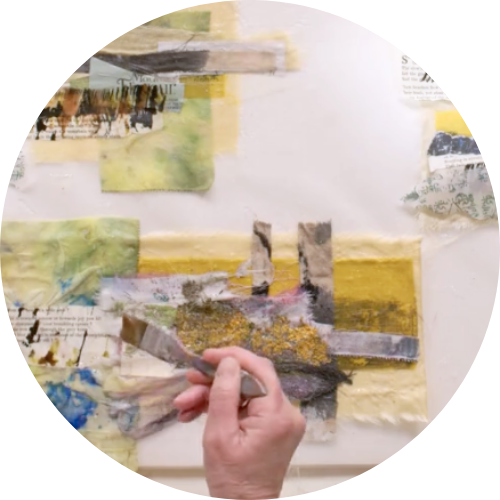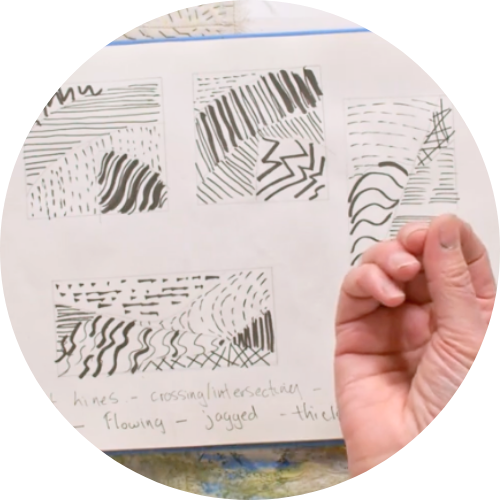The best, most-inspiring and value-for-money course. A huge thank you Cas. The best, most-inspiring and value-for-money course, both online or in person, I have ever done. It’ll continue to inform my journey into textile art for a very long time. All good wishes to you for some family time. Hoping to meet you one of these days.
JANINA B
I believe Cas to be one of the best teachers I have ever had. She is an extremely talented artist and a highly skilled teacher. She knows how to get down the nitty-gritty of concepts and can explain the ‘how to’. Not everyone has both these talents!
CHEZ A
Exactly what I needed to re-inspire me. A big thank you Cas. I have really enjoyed your course. I needed a break from my own art practice during our COVID lockdown, & your course was exactly what I needed to re-inspire me. Everything I’ve learned from you in this course will integrate nicely with my painting. Thank you again & the Fibre Arts Team for such great online courses.
SUE S
I've learned so much and am exploring so many different ideas based on your course. I’ve added sketches, drawing and watercolor painting to my fabric sewn and embroidered wall hangings. I have more ideas than time to do them because your work really encouraged, inspired and added to my education!! Thanks for giving of your time to us!
NilaMae H
This course cracked me right open to challenge and change (in a good way) and I’ve said it before, I don’t think I will ever be the same again creatively. Drawing and sketchbooks are my challenge but will also be my way to continue exploring and finding my own voice. I never knew how to get started with these, now I do. The experience of being in this group has also been wonderful, kept me moving forward, inspired me with the work being produced and encouraged me with kind feedback. The Fibre Arts Take Two platform is also a thing to behold. The quality of the materials, the warm, encouraging, attentive input into this group, bringing a disparate international group of people together in such a cohesive way.
HELEN R
Has helped me break down my artist’s block. Huge thanks to Cas for a truly inspiring course, which has helped me break down my artist's block and taught me to look and play with materials again.
SUE B
Create texture and depth in your artwork, using layering and stitching techniques with paper and cloth...
Leave a lasting impact with meaningful textile art
Closing the gap between material and meaning is one of the most important things you can do as an artist.
Imagine translating seemingly ordinary materials into stunning textile art, layered with meaning.
In Making Connections with Cas Homes you’ll learn to do just that. You’ll delve deep into the thought process and methods Cas uses to create her famous textile landscapes.
This is where learning from Cas Holmes really benefits your art practice, as Cas understands the importance of creating a dialogue with the materials you use. She creates artwork layered with meaning by piecing together somewhat disparate materials so they can weave in their own history onto the work and ultimately stimulate the viewer’s imagination. And as you work through the course you’ll uncover your voice and your own connections to the work you create.
Cas also knows that before you unlock your creativity and elevate your artistry first, you must be willing to take a risk.

Making Connections is for those willing to take a risk and become empowered to create work that truly reflects their unique voice and perspective.
Making Connections provides you with the space to…
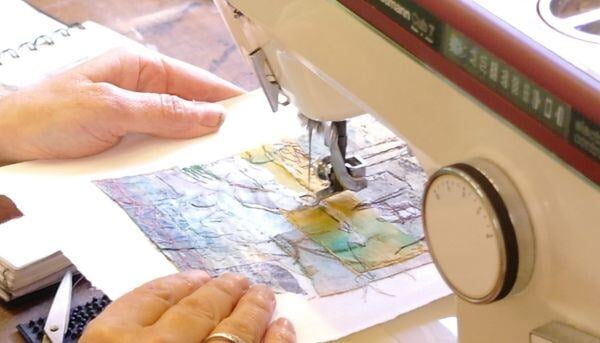
Connect Drawing to Stitch
Learn new ways to observe and evaluate your world and fall in love with sketching. Everyday objects will stimulate the narrative in your work and you’ll see how everything is connected.
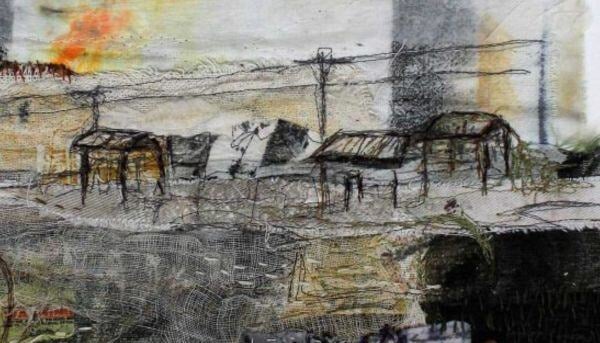
Create Your Own Story
Through Cas’s playful nature, you’ll learn to let go of the outcome, embracing uncertainty as part of the investigative and discovery process that leads to invention and experimentation.
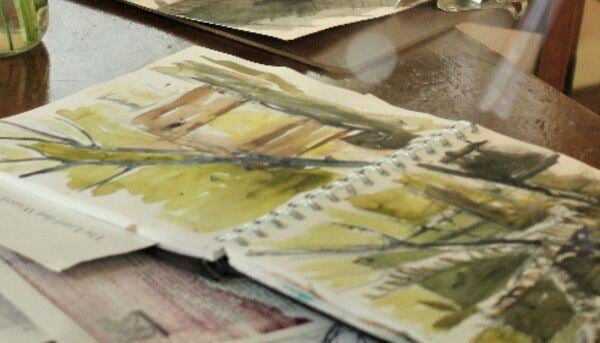
Find Meaning in the Process
Learn methods to transform raw materials and found objects into individually designed mixed media and textile works that have a connection to a place, landscape or family history.
MODULE 1: LOOKING DIFFERENTLY
Cas will demystify the sketchbook, allowing you to let go of the old belief “I can’t draw!” Drawing may seem hard at first, but under Cas’s guidance, you’ll learn how to engage with your own narrative through your sketchbook to create your own story. From traditional spiral bound to creating your own improvised sketchbooks, you learn how to work on different surfaces using techniques including continuous line drawing and how it relates so well to free-motion stitching.
Topics covered include:- Introduction to sketchbooks
- Process of discovery
- Continuous line drawing
- Isolating textures
- Using a view finder
- Imperfect sketchbooks
- Telling your story with sketchbooks
MODULE 2: DRAWING, OBSERVATION & APPRECIATION
Cas will now take you deeper into how to develop what you have discovered. By laying the foundations of a daily sketch practice and bringing the outside in, you have the stimulus for your work to progress. Through a series of achievable exercises, including isolation techniques, exploring colour and tonal value together with the beginnings of the layering process through instinctive collage, which is surprisingly similar to how you’ll later work with paper and cloth, you begin to appreciate how everything is related to the sketchbook.
Topics covered include:
- Isolating your work
- Working with tone value
- Drawing meets collage
- Instinctive collage
- Adding line and colour
MODULE 3: CONNECTING DRAWING TO STITCH
Building on what you have been developing with your observations, in this module, you’ll understand why the connection between drawing and stitch is so strong. Using the sewing machine with simple exercises and consideration to help you build your confidence with free motion stitch by following forms on paper and constructional straight stitch, with seams and folds. You’ll learn what types of papers work best with machine stitching and why Cas prefers mechanical machines as a simple tool for making a mark with stitch.
Topics covered include:
- Sewing machine basics
- Seams – expectations about paper
- Adding dimension straight stitch seams and folds
- Free motion stitching
- Machine stitching into a sketchbook
MODULE 4: PRINTING WITH MEANING
Use what’s available from the garden, kitchen and your surroundings to make marks on cloth and paper using printing and other mixed media techniques. You’ll now have the opportunity to build a library of textured cloth and paper to use throughout the course using printing methods Cas has adapted over many years. Explore relief printing with textured cloth, botanicals and printing using different paint and dye mediums whilst discovering their unique qualities. There's no need for expensive presses; use what you have to create amazing results.
Topics covered include:
- Ink on folded cloth
- Ink on paper
- Relief printing
- Printing with botanicals
- Staines, dyes and wallpaper
- Staining paper
MODULE 5: AUDITIONING MATERIALS
It’s time to find joy in the accidental by looking at your marks in a new light. Using your printed materials and other materials you enjoy working with; this is the beginning of where painting meets cloth and your printing meets textile collage. As you move through the auditioning process, continuing to investigate what your materials can do and what colours you might use, you’ll create some dry sampling in preparation for module 6.
Topics covered include:
- Visualisation process
- Colour palette study
- Auditioning layouts
- Cloth collage
- Introducing elements
MODULE 6: LAYERING MATERIALS - WET APPLIQUE METHOD
Establishing and continuing your line of enquiry with your found materials you’ll explore how your work and materials further respond to Cas’s unique wet applique method. Temporarily laminating your cloth together allows you to use your sewing machine without pins giving you the freedom to move more instinctively. Step outside of your comfort zone and have some fun by having a go at a new temporary method.
Topics covered include:
- Qualities of cellulose adhesives
- Why we use adhesives
- Wet applique
- Lamination process
MODULE 7: CONNECTING YOUR STORY THROUGH STITCH
Stitch holds everything together. Using your machine to stitch into your dried pieces, you’ll discover how the newly created surfaces respond and how you can further extend your ideas and meaning within your work. You’ll realise this is not a linear process; things can keep moving forward or backward at any time, remembering the primary motivation is constantly discovering new things. You’ll move your palette around the table, rediscover, rework, and destroy to create, take a risk never to stop reimagining.
Topics covered include:
- Working with dried pre-pasted pieces
- Straight and free motion machine stitch
- Relationships between material
- Machine stitching a drawing
- Extending your own ideas
MODULE 8: HAND STITCHING
Discover different ways of making a mark, from the fast and vibrant machine stitch to the more contemplative and reverent hand stitch. Explore why hand stitch is as equally relevant as making a mark with a machine, by using slow stitch to take a moment to focus and slow down by creating sampler pieces exploring french knots and different textures learning to use your threads as a paint palette, re-evaluate your work whilst enjoying the simple things in life.
Topics covered include:
- Physical and mental stitching tools
- Why we use stitch
- Connecting to touch hand stitch exercise
- Stitching on a smaller piece
- Stitching the wrong side and French knots
- Finding connections
- Mounting & hanging textile artwork
Inside your course

LEARN AT YOUR OWN PACE - UNLIMITED ACCESS:
Once enrolled, you’ll gain instant and lifetime access to hours of beautifully filmed content, with behind-the-scenes insights through a comprehensive workshop that would be impossible to share within the time limitations of a live class.
By fully engaging with the course content, you will try different techniques while being encouraged to engage your senses, experiment with materials, and ultimately expand your creative toolbox with fresh ideas and concepts to incorporate into your art practice.
Having lifetime access means our online method allows you to slow down, take your time, and dig into the modules and learnings that speak to you, embedding your learning. You have endless opportunities to take the lessons – to come back, re-watch, and learn more as your own ideas and techniques evolve.
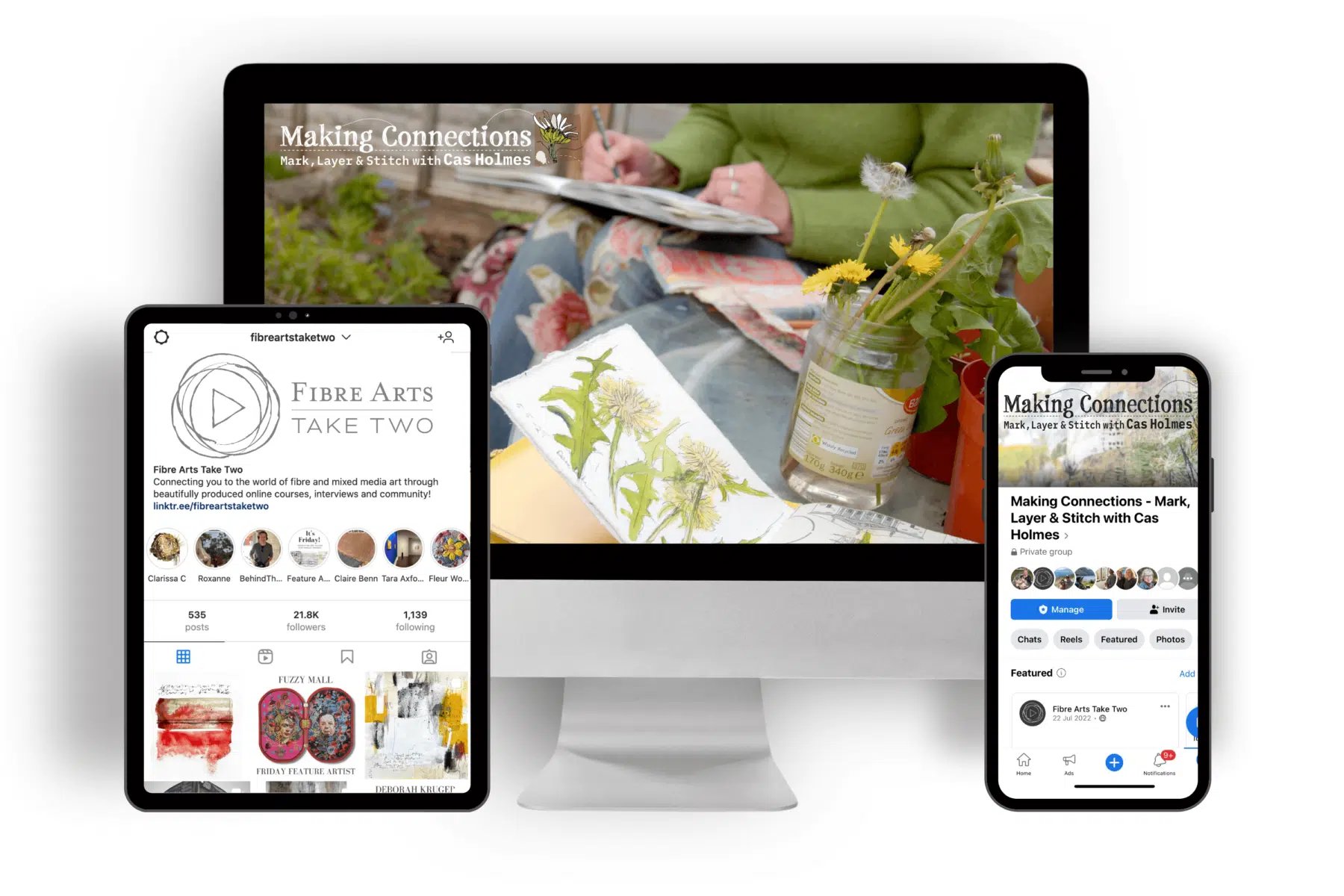
WORLDWIDE COMMUNITY
Having an online community of fellow creatives exploring new creative approaches is an extraordinary experience. Past participants of our programs have experienced significant breakthroughs by being exposed to the works of other members. They have been particularly inspired by fresh ideas from viewing other students’ creations. Therefore, we are delighted to provide you lifetime access to an exclusive Student community hub for all On-Demand students, offering an even more expansive space to connect, feel inspired, and learn.
“The community has been such a blessing, and I’m honoured to see what everyone has created and shared continually” – Eunice Rieken.
Here’s how we make sure you grow your creativity
Regardless of whether you feel inspired to learn a brand new technique…
Or inspired to improve a technique you already love…
And regardless of whether you feel pulled to touch on every technique and process…
Or decide you want to spend 90% of your time on ONE module…
You are free to EXPLORE and make this unique program work for YOU.
Each lesson was crafted to empower you in a way that makes sense for whichever season of life you’re currently in.
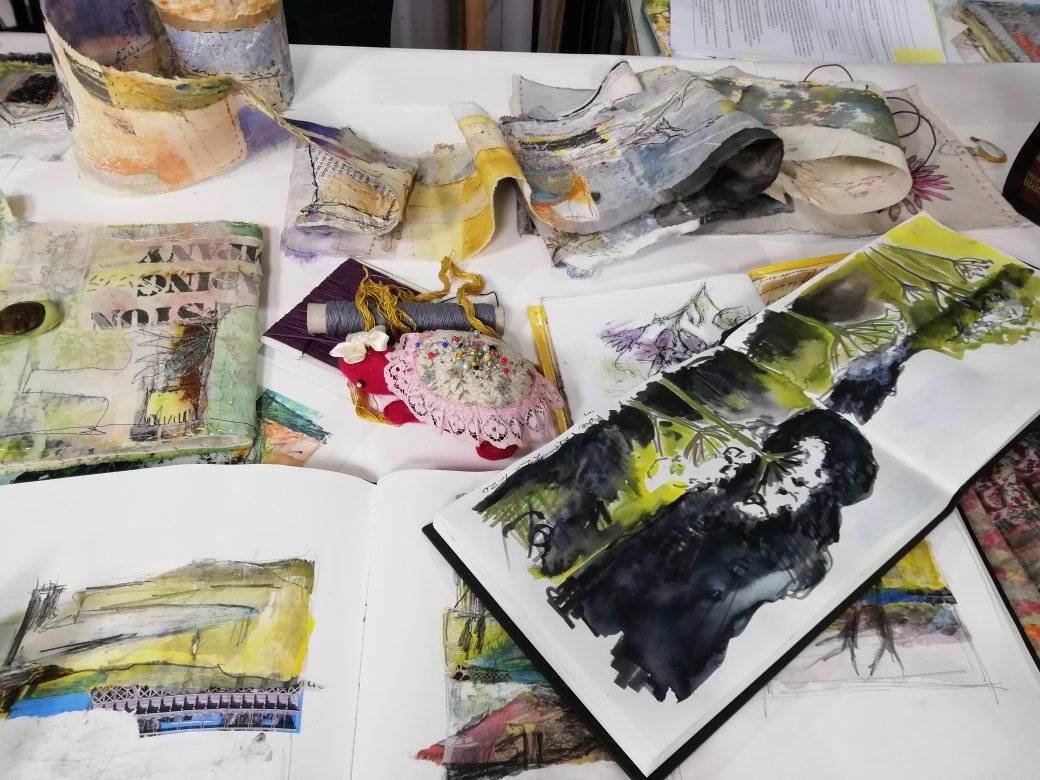
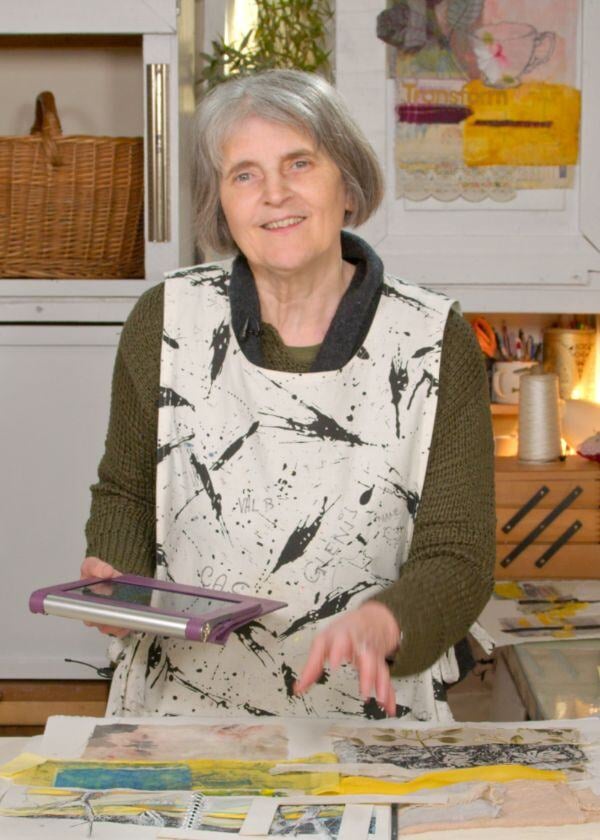
Cas Holmes
Cas is an internationally renowned artist, writer, and lecturer celebrated for her innovative work in textiles and mixed media. She seamlessly blends her background in fine art painting and photography into her creations, exploring the intricate spaces between natural and urban environments and the personal connections within.
Her unique approach, often described as "Painting with Cloth" and "Stitch Sketching," involves a fluid, intuitive process that breathes new life into discarded materials, offering a glimpse into the overlooked simplicities of daily life.
Author of acclaimed books like Stitch Stories (2015), Textile Landscape: Painting with Cloth (2018), Embroidering The Everyday (2021) and recipient of numerous awards, Cas's work extends beyond the canvas into community collaborations focused on environmental themes.
These projects enrich her art and forge deep connections across communities worldwide. Cas's work, which has graced collections from London to New York to Australia, invites us into a world where every piece tells a story, encouraging us to find beauty and commonality in our surroundings.
Create artwork that truly reflects your
unique voice and perspective.
A lifetime of learning and exploration awaits.
WHAT'S INCLUDED
-
8 Modules with Individual Video Lessons
-
Comprehensive Resource Guides
-
Lifetime Access
-
Private Facebook Student Hub
-
Learn at Your Own Pace
-
Professionally Filmed Content
We understand that choosing the right course is essential for your artistic journey.
Here's how Making Connections stands out from other fibre art courses:
Exploration: This course is focused on found materials and is ideal for anyone who sometimes feels a little bit uncertain about their work and the direction they're going in. You’ll discover things about yourself and many processes and techniques that you can adapt to how you choose to work.
Creative Freedom: Making Connections encourages you to let go of the outcome, embracing uncertainty as part of the investigative and discovery process that leads to invention and experimentation.
Comprehensive Learning: With 8 modules and hours of professionally filmed content, Making Connections offers an immersive learning experience. You'll receive comprehensive downloadable resource guides to support your journey.
Personal Growth: Making Connections is designed to help you unlock your inner artist, regardless of your skill level. It's an opportunity to explore and expand your creative horizons. You’ll also build confidence in creating compositions relating to things you have seen and discovered.
Frequently Asked Questions
If your question isn't answered below please contact the Fibre Arts Take Two team at
support@fibreartstaketwo.com
-
Immediately after you enrol, you’ll receive an email with all your login details to access hours of professionally filmed footage and a gamut of resources. The course begins as soon as you are ready!
-
Of course! From the moment you join us - you will receive the entire eight-module Making Connections curriculum, with access to it for life. You’ll also receive Q&A recordings from Cas of all the most pertinent questions that have come in from the course. And to wrap it all up - Cas has you covered with all her written resource guides and creative prompts to accompany each module!
-
We welcome you to join our closed student hub on Facebook, where you can interact and share your work with other participants from around the globe. Be inspired and meet other artists.
Not on Facebook? Don’t worry; you’re always invited to join the conversation!
You’ll be able to share your work with us and others using # tags that are released during the course.
Perfect if you'd love to move through a course with a group of like-minded people and feel part of a community.
On-Demand courses are designed for people who want access to top-quality training now and are happy to work through the curriculum and extensive resources (including curated videos of FAQs from past students) at their own pace. They offer an online private student community but have no official tutor interaction, live Q&As, or exhibitions. Enrolment is always open for On-Demand courses.
Great for those on a budget who still crave access to learn the techniques and processes of the world's best Fibre and Mixed Media Artists and a library of knowledge they can access for a lifetime.
Making Connections is an On Demand online course with no official tutor interaction, live Q&As or exhibitions. -
Making Connections has been meticulously organised to help serve all walks of life - even for those who aren't overly tech-savvy. (One of the biggest differentiators we continually hear is how well organised and easy to consume the course is, plus how top-notch our customer service is!) So know that we make it simple for you to get what you need - and we are ALWAYS just a message away. You can also access everything wherever you feel most comfortable - your computer, phone, or tablet.
-
Not at all. This course was created with you in mind – the creative who wants to watch in your own time, hit pause, re-watch, take a break, and then return for more!
-
A list of Minimum requirements can be downloaded here: Materials guideline
A full list of materials is supplied once enrolled.
-
If you have more technical questions or cannot join the student group, you can contact support@fibreartstaketwo.com
-
Absolutely! The course content is fully responsive, so it will work regardless of whether you’re on a computer or mobile device. All you need is an internet connection.
-
As a global company with students from all around the world, we have geolocation set up to try and accommodate where we can! Therefore, we currently accept USD, AUD, GBP, CAD, EUROS and NZD. If your currency isn’t mentioned, your bank automatically converts it to your local currency once the charge goes through.
(On the topic of being international, Fibre Arts Take Two course producers are based in Australia… hence the spelling of things like fibre, realise and enrol!)
A final note from Cas
My application of material and media has been described as ‘painting with cloth’. Bridging the worlds of textiles and colour, mark and stitch I find this liminal space a rich and challenging ‘in-between world’ in which to practice and welcome you in joining me there on this ‘Making Connections’ course.
My references come from the everyday, the world around me, and of course, the landscape.
The depth and tactile nature of textiles and their manipulation with colour and mixed media is particularly apt when trying to portray the shapes and forms we see in the world around us. In turn, the texture, details, shapes and colours of the outside world provide an infinite stimulus for the artist to draw upon.
Where these two worlds meet, the world of the painter and that of the stitcher, is where I ask you to engage with the course, drawing upon the subjects that stimulate your imagination as you ask what if? What next?
This course is not so much a ‘how to’ as opposed to a ‘why to’. I look forward to seeing how your work evolves and your understanding deepens, as you translate your learning into the art you want to create.
By way of explanation, according to the Oxford English Dictionary the word liminal comes from the Latin word limen, meaning threshold, relating to a transitional or initial stage of a process, or occupying a position at, or on both sides of, a boundary or threshold. A liminal space is the time between the ‘what was’ and the ‘next.’ a place of transition, waiting, and not knowing.




